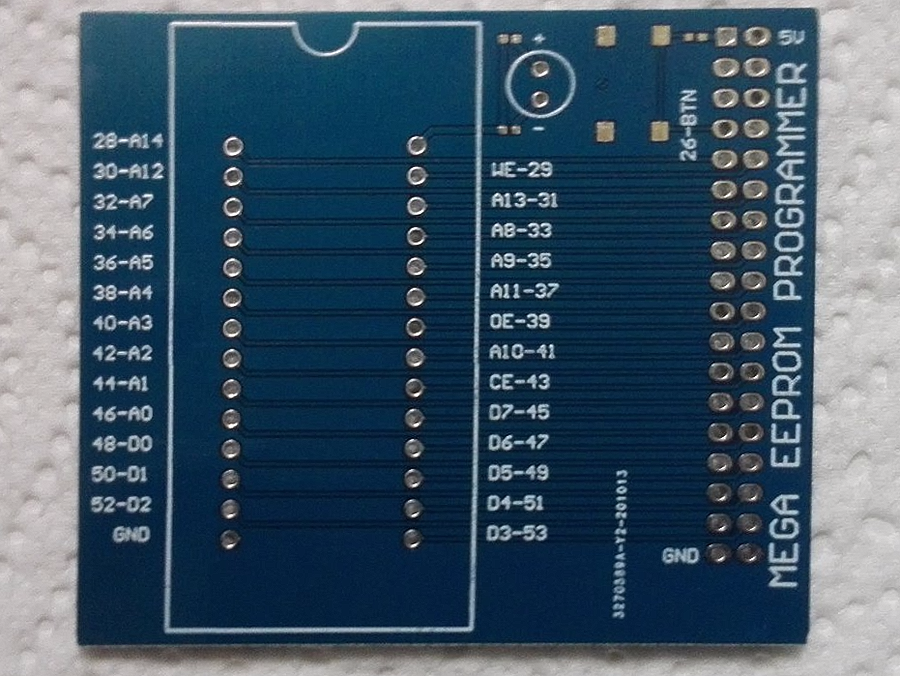

To test the program I took the EEPROM which previously displayed "Goodbye, Cruel W" and changed the letter "l" (0圆8" to "t" (0x74). In fact the write process is very simple: disable the output pins, set address and data values on the bus then pulse Write Enable low for 1 microsecond to write data. It uses a nano and shift registers instead of a Mega to read/write the EEPROM but it provided useful hints for me to write to the EEPROM. Functionally this program was very similar to the 6502 video program to read from memory, so it was easy to implement in a sketch.īen has an Arduino EEPROM programmer as a separate video tutorial.
#Arduino eeprom programmer serial#
I firstly wrote a sketch to read data from the EEPROM and display on the Arduino serial monitor. I started with a separate breadboard EEPROM with digital I/O pins on an Arduino Mega 2560 connected to each I/O pin. The TLS EEPROM programmer I have been using doesn't require special hardware capabilities so providing I connect the Mega to the three EEPROM control pins (Output Enable, Write Enable, Chip Enable) I should be able to write programs to it. I have a Mega 2560 attached to the 6502 board connected to the address and data buses and therefore connected to most pins on the AT28C256 EEPROM.

#Arduino eeprom programmer code#
My priority is to see if I can avoid the need to remove the EEPROM, burn new code in a programmer, and replace it each time I write, amend or correct a 6502 assembly program. The Arduino and Genuino 101 boards have an emulated EEPROM space of 1024 bytes. Anyway, thought this might be of interest to someone, hope it helps.Having substantially completed Ben's 6502 Hello World project I can start to think what to progress myself. The supported micro-controllers on the various Arduino and Genuino boards have different amounts of EEPROM: 1024 bytes on the ATmega328P, 512 bytes on the ATmega168 and ATmega8, 4 KB (4096 bytes) on the ATmega1280 and ATmega2560. Normally you check for the end of the EEPROM write cycle by reading back data from the EEPROM and checking if bit 7 of the data read back is equal to bit 7 of the data being written. That keeps the device from corrupting when the arduino boots up. The code waits 1 ms after programming every byte, but the write cycle time of an EEPROM can be larger than that see the AT28C256 datasheet, page 9. Actually you do need one component, a pullup resistor on the write enable line. This is perfect, both the serial EEPROM and the ATmega328P have SPI. Could you use a capacitor to shorten it Howard Sheppard 1 year ago. I generate the array at the top of the sketch with some regex in notepad++ from the intel hex files (making sure to strip the checksum and other metadata). In order to use the Arduino as an ISP programmer, we need to uplaod a code to it so. So a delay of 1 microsecond (from Arduino) is a bit long for programming the EEPROM. I had an arduino mega 2560 on hand so this was a convenient no-component solution.
#Arduino eeprom programmer Pc#
I couldn't find an existing arduino sketch that suited, a few rely on a clunky pc interface to send the data, or use a bunch of port expanders. Code is here: (You'll need to modify it to suit your wiring but it's dead simple) I needed this for the Z80 machine I'm building (following this: ). You can easily store the whole EEPROM image in flash, and program the device without any messy communications with a PC. AVRs have a lot of flash memory (256k in the case of the atmega2560 I'm using), much more than the EEPROMs I needed to program (16k). Hi, just thought I'd share a neat trick I've been using to program parallel EEPROMs using an arduino.


 0 kommentar(er)
0 kommentar(er)
